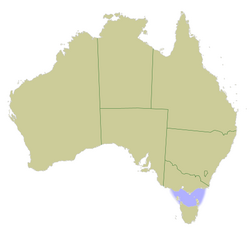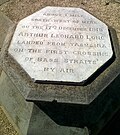Bass Strait
This article may have too many red links. |
Bass Strait is a sea strait separating Tasmania from the south of the Australian mainland, specifically the state of Victoria. The strait was named after George Bass who travelled it in 1798.[1]
It is about 240 km wide at its narrowest point and generally around 50 metres deep. It has many islands, with King Island and Flinders Island home to many towns.
The water is very rough, with many ships lost in the 19th century. A lighthouse was built on Deal Island in 1848 to help ships in the eastern part of the Straits. On the west, the Cape Otway Lighthouse was first lit in 1848. Another lighthouse was at Cape Wickham at the northern end of King Island in 1861.
Islands
There are over 50 islands in Bass Strait. Major islands include:
Western section:
South eastern section:
- Furneaux Group
- Flinders Island
- Cape Barren Island
- Clark Island
- and several other islands
North eastern section:
- Kent Group
- Deal Island
- and 3 smaller islands
- Hogan Island
- Curtis Island
Bass Strait Media
Monument commemorating the first flight across the Bass Strait, by Arthur Leonard Long in 1919. Note the spelling "Straits".
The shoreline of Tasmania and Victoria about 14,000 years ago as sea levels were rising, showing some of the human archaeological sites – see Prehistory of Australia
Shortest distance between the coasts of Bass Strait: South West Point on Wilsons Promontory to the northern tip of the Stanley peninsula
References
Other websites
![]() Media related to Bass Strait at Wikimedia Commons
Media related to Bass Strait at Wikimedia Commons





